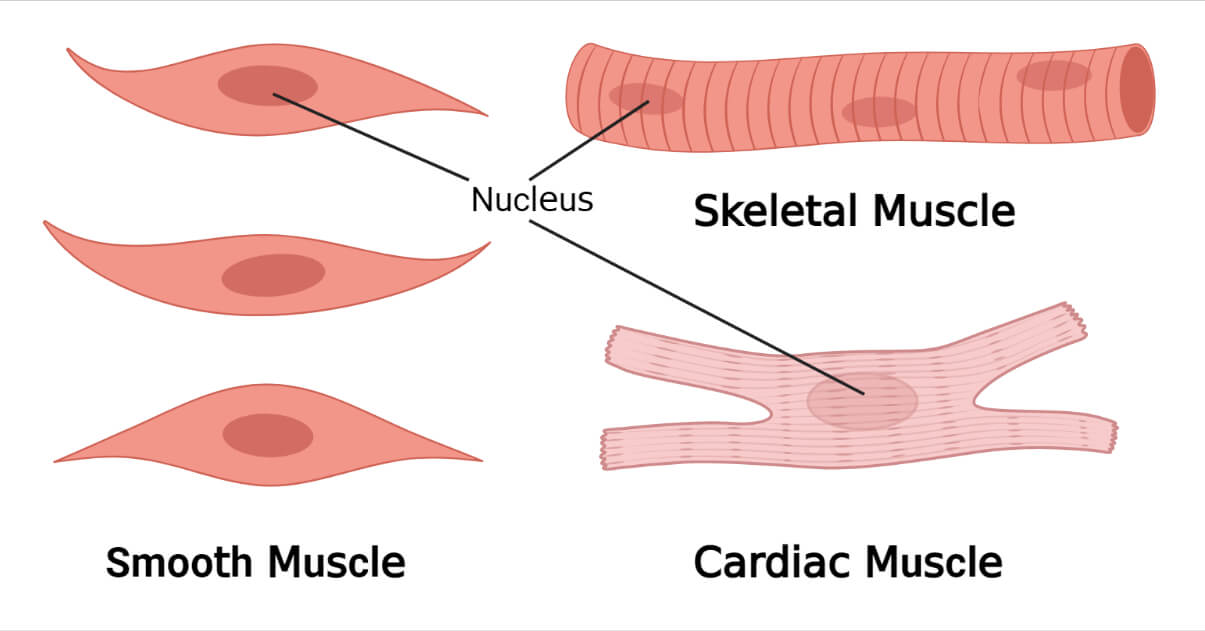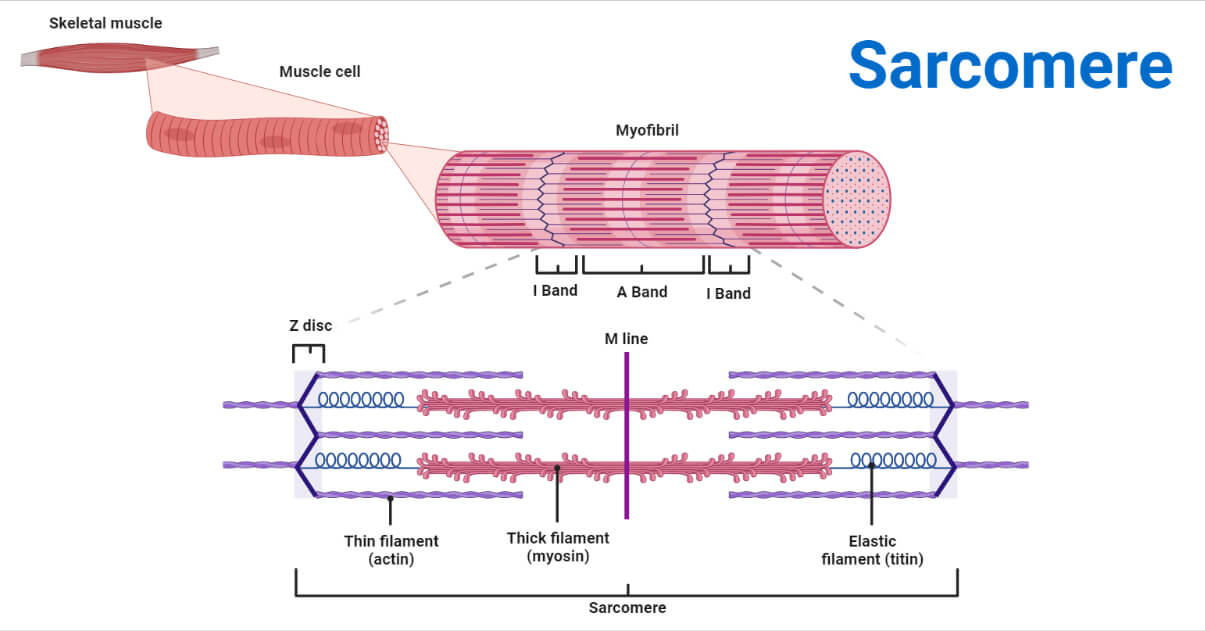Muscle tissues are the soft body tissue of animals made up of thin, elongated muscle fibers that generate and apply forces for the movement and functioning of different parts of a body. They are contractile, extensible, elastic, and excitable in the property. Muscle tissues are made of muscle cells called myocytes. Myocytes combine to form long muscle fibers which combine together to form muscle. On average, about 40% of a person’s weight is muscle.

Interesting Science Videos
Types of Muscle Tissue Based on the Structure and Function
Based on structure and function, the muscle tissues of vertebrates (including humans) are classified into three types, viz. skeletal muscle, cardiac muscle, and smooth muscle.
a. Skeletal Muscle
- The muscles that are attached to the bones by tendons are called skeletal muscles. In general, skeletal muscle is simply referred to as the muscle of a body. Skeletal muscles are voluntary muscles – these muscles’ movement can be controlled by the somatic nervous system i.e. can be moved according to our will. There are more than 650 different skeletal muscles in an average adult human body accounting for about 40% of the body mass.
- These muscles are formed by hundreds to thousands of longer and striated (having striped appearance) muscle fibers. The repeated units of actin and myosin proteins are organized within a myofibril into a sarcomere. This forms an alternating dark and light band of filaments giving a characteristic striated appearance to the muscle fibers.
- Each muscle fiber is around 20 to 100 μm thick and may measure about 20 to 35 cm. About 200 to 250 such muscle fibers form a bundle called the primary bundle which is the functional unit of muscle tissue.
- Each fiber bundle and muscle is externally coated by fascia (a layer of connective tissue primarily of collagen). Fascia covering each muscle fiber is called the endomysium. Such coated muscle fibers are bundled together and externally covered by another layer called perimysium forming a primary bundle. Several primary bundles are grouped and coated externally by another layer of fascia called the epimysium forming secondary bundles (meat fibers). The muscle fibers are arranged in four basic patterns (viz. circular, convergent, parallel, and pinnate pattern) to form a skeletal muscle.

b. Cardiac Muscle
- The muscles forming the wall of the heart are called cardiac muscles. The cardiac muscle is also called the myocardium or heart muscle. These muscles form the pericardium and the endocardium layer of the heart wall. Some of them are also found in the wall of the aorta, the pulmonary veins, and the major vena cava.
- The myocardium is formed by cardiac muscle cells called cardiomyocytes. These cardiomyocytes are interconnected by intercalated discs and are externally coated by an extracellular matrix primarily of collagen fibers along with elastin and polysaccharides. Cardiac muscles are also striated like skeletal muscles; however, they are involuntary.
c. Smooth Muscle
- Smooth muscles are non-striated, involuntary muscles mostly found in the walls of body organs and linings of hollow organs like blood vessels and GI tracts. These muscles don’t contract rapidly and quickly, rather their contraction is smooth and continuous, also they lack striation; hence they are called smooth muscles. They are formed by small uninucleated spindle-shaped muscle cells.
- These cells have abundant Golgi bodies, ER (endoplasmic reticulum), desmin, elastin, vimentin, and collagen than other muscle types but contain fewer mitochondria.
- Smooth muscles are further sub-categorized into single-unit smooth muscles and multi-unit smooth muscles. Single-unit smooth muscles are also called visceral muscles and are found in the lining of internal organs, blood vessels, the urinary tract, and the GI tract. They are myogenic in nature. Multi-unit smooth muscles are found in the lining of the iris, trachea, and large elastic arteries. They are neurogenic in nature.
Types of Muscle Tissue Based on the Nervous System Involved in Control of the Muscle Movement
a. Voluntary Muscles
Those muscles whose movements are under the regulation of the somatic nervous system are called voluntary muscles. As the name suggests, they can be moved according to our will. Skeletal muscles are voluntary muscles. Such muscles are powerful and very important in maintaining the shape, posture, strength, and movement of our body. However, they quickly become exhausted and need lots of energy to contract and relax.
b. Involuntary Muscles
Those muscles whose movements are under the regulation of the autonomic nervous system are called involuntary muscles. These muscles’ movement can’t be governed according to our will; instead, they regularly and rhythmically move on their own. Cardiac muscles and smooth muscles are involuntary muscles. Such muscles show smooth and less powerful contractions. They don’t usually get exhausted – some like cardiac muscles don’t get exhausted by contracting and relaxing throughout life. They also need comparatively less energy for their movement.
Functions of Different Types of Muscle Tissues
Functions of Skeletal Muscles
- The movement of different body parts due to contraction is the primary function of skeletal muscle.
- They provide proper shape and strength to our bodies. Skeletal muscles generate force to perform any physical action.
- Regular contraction and relaxation generate heat and maintains proper body temperature.
- They provide protection to viscera.
- They stabilize the skeleton and body joints.
- They react to reflexive nerve stimuli and perform sudden reflex action.
- Skeletal muscles are store house of nutrients and minerals.
Functions of Cardiac Muscles
- They form the muscular wall of the heart.
- They support regular contraction and relaxation of the heart.
- Some cardiomyocytes are responsible for the generation of cardiac impulses.
Functions of Smooth Muscles
- They form a contractile component of the digestive tract, respiratory tract, urinary tract, and reproductive tract.
- They are responsible for the regular involuntary movement of internal organs and vessels/tracts.
- They change the diameter of visceral organs and vessels.
- They form a supportive lining/wall of viscera.
Skeletal vs. Cardiac vs. Smooth Muscles
| Skeletal Muscle | Cardia Muscle | Smooth Muscle |
| Each muscle cells are multinucleated and are arranged in the periphery | Each muscle cells are with 1 to 2 centrally located nuclei | Each muscle cells are uninucleated |
| Muscle cells are long and cylindrical in shape | Muscle cells are short, fusiform, and branched | Muscle cells are short and spindle in shape |
| Striated muscle fibers | Striated muscle fibers | Non-striated muscle fibers |
| Innervated with the somatic nervous system | Innervated with the autonomic nervous system | Innervated with the autonomic nervous system |
| Voluntary muscles i.e. can be moved according to our will | Involuntary muscles | Involuntary muscles |
| Intercalated disc absent | Intercalated disc present | Intercalated disc absent |
| Found attached to bones | Found in the heart wall | Found in walls of body organs and tract (vessels) |
| Troponin protein is present | Troponin protein is present | Troponin protein is absent |
| Fatigue very quickly | They are always in regular contraction and relaxation cycles without being fatigued | They become fatigued slower than skeletal muscles |
References
- Ross & Wilson Anatomy & Physiology in Health and Illness. 13th ed. Churchill Livingstone Elsevier. ISBN 978-0-7020-7276-5
- Keith L. Moore, Arthur F. Dalley, A. M. R. Agur. Clinically Oriented Anatomy. (2013) ISBN: 9781451119459 – Google Books
- Tortora, Gerard J.; Nielsen, Mark T. (2009). Principles of Human Anatomy (11th ed.) John Wiley & Sons. pp. 84–5. ISBN 978-0-471-78931-4.
- Wood, Bernard , Davies, Robert E. , Warshaw, David M. , Alexander, Robert McNeill , Alpert, Norman R. , Gergely, John , Newsom-Davis, John M. , Walker, Warren F. , Curtin, Nancy A. and Crompton, Robin Huw. “muscle”. Encyclopedia Britannica, 11 Feb. 2023, https://www.britannica.com/science/muscle. Accessed 20 April 2023.
- 12.3 Types of Muscle Tissue – Human Biology (pressbooks.pub)
- Striated muscle: Structure, location, function | Kenhub
- 4.4 Muscle Tissue – Anatomy & Physiology (oregonstate.education)
- Muscles and muscle tissue: Types and functions | Kenhub
- Muscle Tissue: Definition, Function & Types | Biology Dictionary
- 15.3: Types of Muscle Tissue – Biology LibreTexts
- Types of Muscle Tissue | Physiology | Geeky Medics
- Muscular Tissue – Structure, Functions and Types of Muscular Tissue (byjus.com)
- Muscle: Types of Muscles, Functions & Common Conditions (clevelandclinic.org)
- Muscle Tissue Types | Learn Muscular Anatomy (visiblebody.com)
